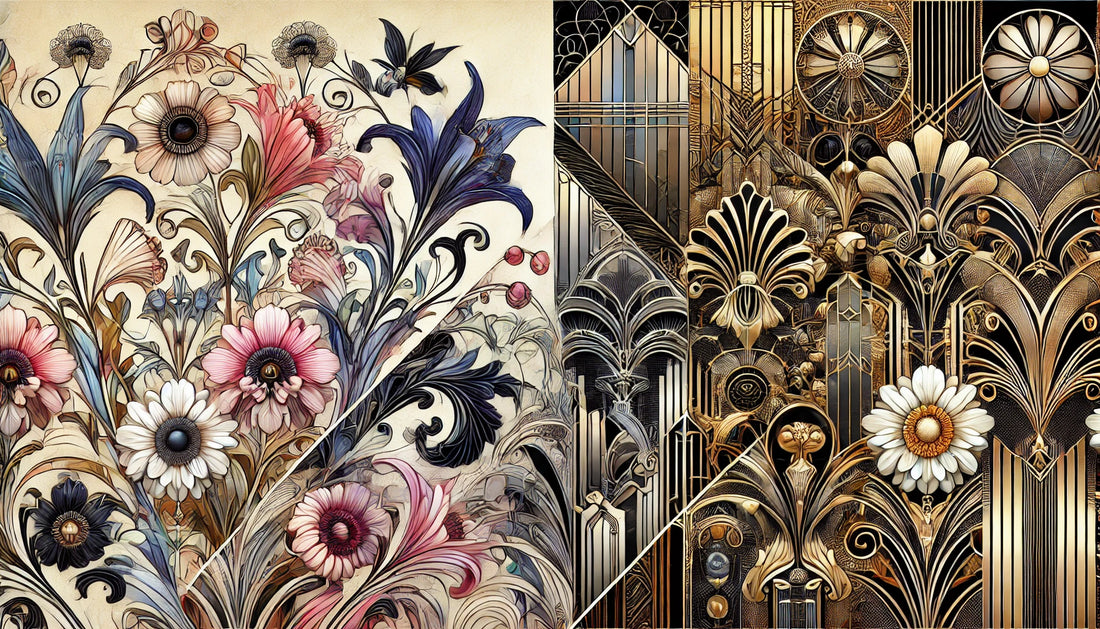
Art Deco vs. Art Nouveau: Distinguishing Two Iconic Movements
Share
Art has always been a mirror to society, reflecting cultural, economic, and technological shifts. Among the many artistic movements, Art Nouveau and Art Deco stand out for their enduring appeal and influence on everything from architecture to furniture, jewelry, and graphic design. Though they are often confused, these styles are distinct, rooted in different eras and ideologies.
In this post, we’ll explore the defining characteristics of Art Nouveau and Art Deco, their historical contexts, and how to identify their unique features.
Art Nouveau: The Dawn of Modernity
Art Nouveau, meaning "New Art" in French, flourished from the 1890s to the early 1910s. It was a reaction to the rigid academic art styles of the 19th century and was heavily influenced by the Arts and Crafts movement. At its core, Art Nouveau aimed to blur the boundaries between art and everyday life, infusing beauty into functional objects.
- Philosophy: Emphasis on craftsmanship and artistic integrity, rejecting mass production.
- Cultural Influences: Inspired by natural forms, Japanese woodblock prints, and medieval art.
- Materials: Focused on fine materials like stained glass, wrought iron, and ceramics.
Art Deco: A Celebration of Modernity
Art Deco emerged in the 1920s and reached its zenith in the 1930s, coinciding with the Jazz Age and the Roaring Twenties. The style embodied modernity, luxury, and progress, reflecting the optimism of the post-World War I era.
- Philosophy: A celebration of industrial innovation, mass production, and modernity.
- Cultural Influences: Drawn from Cubism, Futurism, and ancient art forms (Egyptian, Aztec, and African).
- Materials: Featured industrial materials like chrome, glass, steel, and plastics, alongside luxurious ones like ivory and lacquer.
Key Characteristics
Art Nouveau: Organic Elegance
Art Nouveau is immediately recognizable for its flowing lines, intricate details, and nature-inspired motifs. Its designs feel almost alive, with elements that seem to grow and twist organically.
- Lines and Shapes: Curved lines, whiplash motifs, and asymmetrical compositions.
- Motifs: Flowers, vines, insects (especially dragonflies), and female figures.
- Architecture: Ornate facades, stained glass windows, and ironwork. Famous examples include the works of Victor Horta in Belgium and Antoni Gaudí in Spain.
- Palette: Soft, muted colors such as pastels and earth tones.
Art Deco: Geometric Sophistication
Art Deco, on the other hand, is all about boldness and symmetry. It’s a striking style characterized by clean lines, geometric shapes, and a sense of glamour.
- Lines and Shapes: Straight lines, zigzags, chevrons, and geometric patterns.
- Motifs: Sunbursts, stepped forms, and abstract representations of machinery and speed.
- Architecture: Skyscrapers like the Chrysler Building in New York exemplify its streamlined, futuristic style.
- Palette: Rich, vibrant colors such as gold, silver, black, and deep jewel tones.
Applications in Design
Interior Design
- Art Nouveau: Furniture with curving, plant-like shapes, Tiffany-style lamps, and elaborate wall treatments.
- Art Deco: Sleek, modern furniture with sharp angles, mirrored surfaces, and metallic accents.
Jewelry
- Art Nouveau: Intricate, handcrafted designs featuring enamel, pearls, and nature-inspired themes.
- Art Deco: Bold, geometric jewelry with diamonds, emeralds, and sapphires, often incorporating platinum.
Graphic Design
- Art Nouveau: Flowing typography and illustrations with organic borders, commonly seen in advertising posters by Alphonse Mucha.
- Art Deco: Streamlined fonts and symmetrical layouts with a futuristic feel, often used in travel posters and magazines.
Cultural Impact
Both movements were groundbreaking in their times, setting the stage for modern design.
- Art Nouveau paved the way for the concept of Gesamtkunstwerk, or "total work of art," influencing the integration of design disciplines.
- Art Deco inspired the sleek, minimal aesthetic that would dominate later 20th-century design, including Mid-Century Modern.
Today, both styles are celebrated and revisited in fashion, graphic design, and architecture. Art Deco’s glamour resonates in luxury branding, while Art Nouveau's organic charm appeals to eco-conscious design philosophies.
How to Tell Them Apart
Here’s a quick guide to distinguish Art Nouveau from Art Deco:
| Aspect | Art Nouveau | Art Deco |
|---|---|---|
| Era | 1890s–1910s | 1920s–1930s |
| Shapes | Flowing, curvilinear | Geometric, angular |
| Inspiration | Nature, mythology | Technology, progress |
| Colors | Muted pastels | Bold, vibrant |
| Materials | Stained glass, wrought iron | Chrome, steel, glass |
| Examples | Victor Horta’s Hôtel Tassel | Chrysler Building, New York |
Why It Matters Today
Understanding Art Nouveau and Art Deco is more than an exercise in art appreciation. It offers insights into how art reflects societal values and technological advancements. For creatives, these movements provide endless inspiration—whether you're designing a website, creating a product, or decorating a space.
Art Nouveau and Art Deco are timeless movements that continue to captivate and inspire. While Art Nouveau celebrates nature’s curves and organic beauty, Art Deco glorifies the machine age with its sleek geometry and modern appeal. By understanding their distinct characteristics, you can better appreciate the art, architecture, and designs that shape our world.


